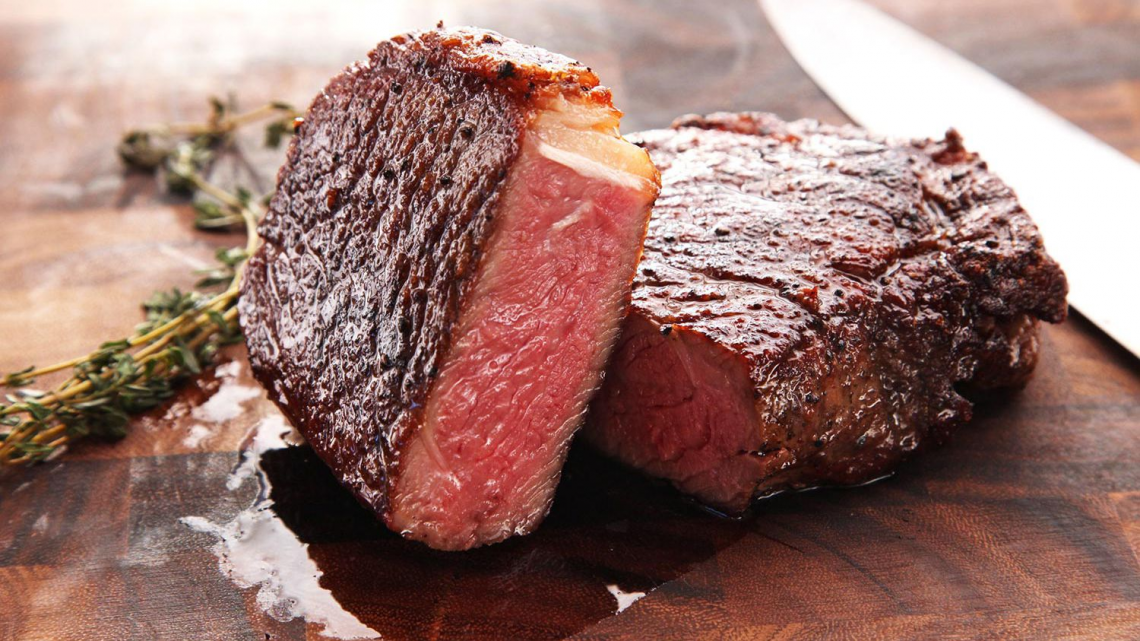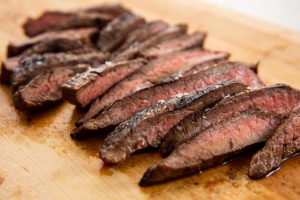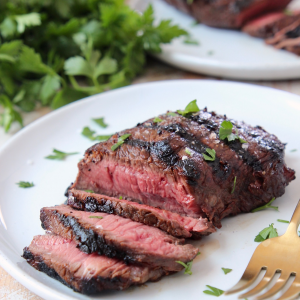
How to cook a good steak
How to choose meat for a steak
1. Take only beef
Just in case, we remind you: only beef has the right to be called a steak. No pork, lamb, or especially chicken! This is the fundamental point.
2. Decide in advance which steak you want
If you think that “steak is steak”, you are wrong. There are about a dozen types of this fried meat. Basically, they can be divided into three groups:

Marble steaks.
They are prepared from the so-called marbled meat: tender, soft, streaked with fat parts of the back and loin (thin and thick edges). This type of steak includes the popular ribeye and striploin.
Lean steaks. Prepared from cuttings. They are also distinguished by tenderness, but at the same time, due to the smaller amount of fat, they are slightly less high-calorie. These include, for example, filet mignon and chateaubriand.
Alternative steaks. Prepared from other parts of beef carcass: shoulder blades, flanks, and so on. These steaks are less fat and tender, rarely have the correct shape and may contain tendons. They are more suitable for lovers of “real” meat, which can be torn with teeth.This type of steaks includes flank, skert, top blade and so on.
Once you’ve decided which flavor and nutritional characteristics you need, go for meat.
Don’t Just Buy Beef
We partially repeat the previous point. The rules are strict: to get exactly the steak that you want, you need to choose meat from well-defined parts of the carcass. A skint steak is always a flank. Top blade – shoulder blade. Rib-eye and striploin – back and loin. Filet mignon is prepared only from the most tender tenderloin – and from nothing else!
4. Be smart
If you are not an expert in choosing and cooking meat, it is better to limit yourself to the classic, most popular and easy-to-cook types of steaks – marbled (ribeye) and lean (filet mignon). The premium parts of the carcass from which they are prepared will be quite edible, including in inexpensive meat.
But alternative steaks will only taste good if they are made from really good, aged grain-fed beef bovine meat.
Check the quality of meat before buying
The meat for a rib-eye steak should be soft and marbled, that is, with visible streaks of fat.
The quality of meat for filet mignon can be checked as follows. Press firmly on the cut with your finger: it should give in easily, but as soon as you remove your finger, quickly return to its previous shape.
We will not talk about the quality of meat for other types of steaks now: it is difficult for a non-professional to determine the necessary characteristics, so it is better to focus on the classics.
Frozen meat is allowed
But it is important to take it only from trusted sellers, so as not to run into a “second freshness product” or the wrong part of the carcass.
Please note that this option will require competent defrosting. In no case do not defrost meat in the microwave or in the sun: a temperature jump will lead to the loss of precious juice, and this will worsen the taste characteristics of the future steak.
About a day before the planned frying
put the beef from the freezer into the main compartment of the refrigerator. So the meat will become soft, but not lose its juiciness.
In general, you can not defrost meat at all.
How to prepare meat for frying
1. Cut the meat perpendicular to the grain
How to cook a steak: Cut the meat perpendicular to the grain
Culinary experiments prove that a steak cut across the muscle fibers is much softer.

The ideal thickness of each piece is 2.5–4 cm.
2. Let the meat reach room temperature
This is important for future uniform frying. If you have time, just take the meat out of the fridge 2-3 hours before cooking and it will warm up on its own.
If there is no time, wrap the future steak in cling film and dip for 20-30 minutes in warm (30-35 ° C) water.
3. Or do exactly the opposite: freeze before frying
It sounds original, but, as the experiment shows, the result is an unexpectedly interesting result: a very juicy steak with a pale pink core.
